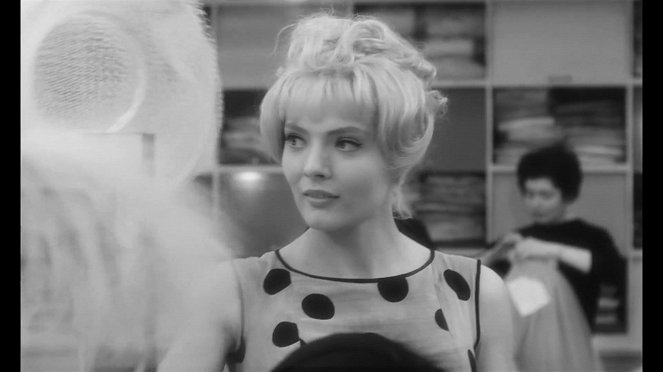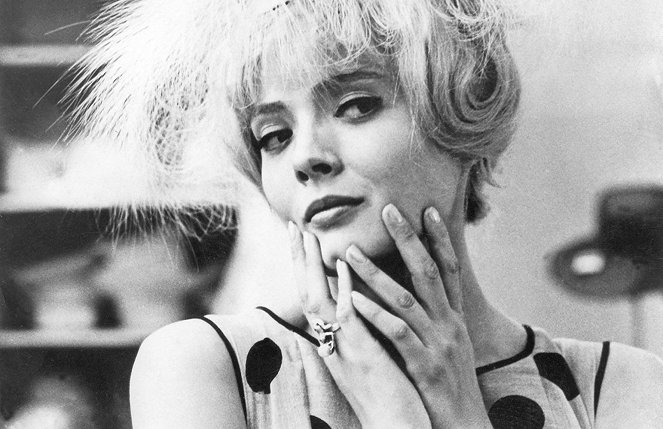Director:
Agnès VardaGuión:
Agnès VardaMúsica:
Michel LegrandReparto:
Corinne Marchand, Michel Legrand, Serge Korber, Jean-Claude Brialy, Sami Frey, José Luis de Vilallonga, Eddie Constantine, Yves Robert, Anna Karina (más)Sinopsis(1)
Cléo, una joven cantante, acude a un hospital para que le realicen una biopsia. Esperando a conocer los resultados de la prueba médica, la mujer deambula dos horas por las calles de París. Su camino se cruza con el de amigos y extraños, como un soldado a punto de partir hacia Argelia. Mientras hablan y caminan, Cléo se confronta a su propio egoísmo, encontrando la paz y abriendo los ojos al mundo. (A Contracorriente Films)
(más)Videos (1)
Reseñas (4)
Cleo de 5 a 7 es para mí la primera película de la nueva ola francesa que me conquistó de principio a fin. Agnès Varda conseguió combinar un guion bien escrito, que en lugar de divagaciones filosóficas desterradas ad absurdum (que es un mal clásico de la nouvelle vague, con perdón de los intelectuales) se mantiene agradablemente a ras de suelo, con una progresión formal distintiva, en la que la película se desarrolla (casi) en tiempo real y documenta una hora y media crítica en la vida de la cantante del título, Cléo. Esta pieza de conversación, bellamente rodada, es en realidad una especie de precursora de la trilogía de Linklater, que comienza con Antes del Amanecer. Disfruté de los noventa minutos en la sala de proyección, cuando ya estaba cansado después de unas cuantas proyecciones, aunque no aparté los ojos de Cléo de Cinco a Siete. Y de hecho, podría haberla visto hasta la medianoche y más allá. [LFS 2019]
()
Considering that the new wave doesn't really suit me, this movie actually got me quite a bit with how kind, beautiful, pleasant, comedic, and dramatic it is at the same time, and it has quite good characters that appear very natural. It is given by the documentary style that was used, as well as the real time that unfolds before you. The film manages to not be boring without any problems.
()
"Nudity is simplicity. Like love, birth, and water. Like the sun, the beach, all of it." It is also fitting to add: like a wave. That is, the new one. The one with its lightness and simplicity in which the director is able to capture Paris in its own thousand reflections and at the same time with all its crowded streets, cafes, and shops. And yet, just as easily capturing the inner self of the main character in her nudity and (this is not meant obscenely) her final unveiling in front of another person and the city itself. The self-centeredness that breeds isolation and detachment from others, characterized by the use of taxis, is overcome by a symbolic transfer to a bus, in which the protagonist can no longer travel alone. Similarly, the exchange of a phone call for a personal visit to the hospital is symbolic - looking the enemy in the face in person is the basis for overcoming and taking responsibility for one's own life.
()
The anti-Amélie, ungraspable in the manner of the New Wave. Agnès Varda was not a passionate cinephile like the directors from the Cahiers du Cinéma circle. Educated in the arts and humanities, she was less fascinated by cinema than by photography and painting (the paintings of Hans Baldung Grien were a major inspiration for the film’s visual aspect). This is perhaps also a reason that her second feature-length film stands out due to its distinctive grasp of traditional narrative forms (Varda likened her creative process to writing books, calling it “cinécriture”). These forms are neither amplified nor deliberately violated. Instead of adopting or disparaging others’ film language, the director came up with her own way of conveying information to us. Despite her creative grounding in documentary work, this does not involve intuitive directing in the vein of Jean Rouch. Cléo from 5 to 7 has a carefully thought-out concept whose seeming disruption with some unexpected digressions serves the narrative rhythm. ___ The false information about the duration of the protagonist’s odyssey (cinq à sept was an earlier synecdochic term for a visit to a by-the-hour hotel) serves to play a narrative game with two interpretations of time: subjective time and objectively passing time (which is regularly pointed out to us by the clock in the mise-en-scéne). This temporal duality is justified by Varda’s lifelong interest in the relationship between the subjectivity of the individual and the objectivity of the environment, which together shape our identity. She always endeavoured to identify both individual and broader social issues, or rather the common ground between them. ___ With respect to the disregard for standard dramatic structure (exposition, complication, development, climax), the segmentation of the film into thirteen chapters is understandable, as it helps to maintain the brisk pace of the narrative. Three longer intertextual interludes – a radio news report (which also serves to contextualise events in the manner of a documentary), a song and the short slapstick Les fiancés du pont Mac Donald (which is by far the most cinephilic sequence of the film, thanks to the small roles played by Godard, whose beautiful eyes were allegedly the reason that Varda came up with the short, Karina and Brialy) – similarly serve as punctuation marks. The song also bridges the “passive” first half and “active” second haf of the film. ___ Until the singing of the sad song “Sans toi” (written by Michel Legrand), during which the protagonist realises the emptiness of her life and her position as a victim, into which she has been pushed in part by those around her, Cléo is merely an object with a beautiful surface and nothing inside, watched by others and – thanks to the ubiquitous mirrors – contentedly watching herself (a display window full of hats brightens her up the most). The voice, including the inner commentary, belongs to others, as does the centre of the shot, which Cléo only complements with her charm, but she never dominates it. In the second half of the film, she changes from dazzling white to sombre black, takes off her doll-like wig and puts on dark glasses, which enable her to voyeuristically watch others without being watched herself (hiding her eyes makes it impossible for others to ascertain her identity). Later, after removing her glasses, she doesn’t only accept the gaze of others, but also returns it. The camera finally takes her point of view and allows her to see others as objects (the visit to a sculptor’s studio). ___ Cléo starts to stand up for herself. She begins to use her voice and control the fear that has paralysed her. The previous presentiment of death is displaced by a maternal motif (mothers with infants, children on a playground), the idea of life. To put it in feminist terms, the protagonist takes control of her own representation in the second half of the film. She stops giving in to melodramatic passivity and changes the way that she sees herself (while others still see her in the same way, as indicated by the soldier giving her a daisy, a symbol of admiration for feminine beauty). The joyless message at the end of this urban road-movie is ultimately not so devastating due not only to the unspectacular form of its delivery, but mainly due to the paradigm shift. After circling Paris (her route more or less forms a ring), Cléo is no longer an actor in a tragedy to which she can only resign herself. She has found within herself the strength to fight and to take control over which genre her life will belong to. But as the nature of her illness admonishes, this will decidedly not involve full control. 90%
()
(menos)
(más)



Anuncio